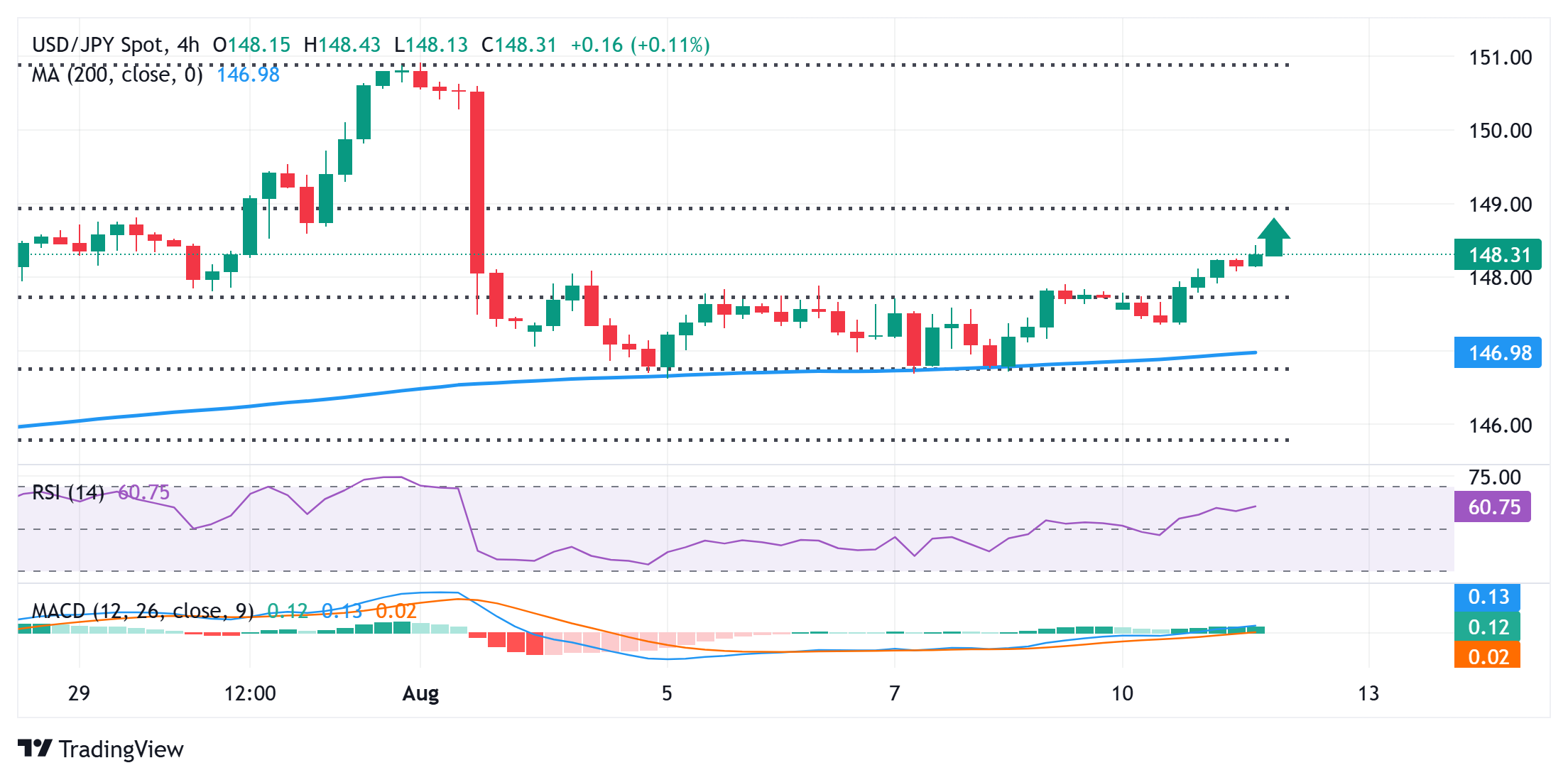Created
: 2025.08.12














![]() 2025.08.12 11:22
2025.08.12 11:22
The Japanese Yen (JPY) drifts lower against its American counterpart for the third straight day and slides to a one-and-a-half-week low during the Asian session on Tuesday. Against the backdrop of political uncertainty, the potential negative impact of higher US tariffs on the domestic economy suggests that the prospects for further policy normalization by the Bank of Japan (BoJ) could be delayed further. This, along with a generally positive tone around the equity markets, continues to undermine the safe-haven JPY.
That said, an upward revision in the forecast for inflation by the BoJ in July leaves the door open for an imminent rate hike by the end of this year. In contrast, the odds of a rate cut by the Federal Reserve (Fed) surged in reaction to the weaker-than-expected July jobs report earlier this month. This, in turn, keeps a lid on any further US Dollar (USD) appreciation and helps limit losses for the lower-yielding JPY. Traders might also opt to wait for the US consumer inflation figures, which might contribute to capping the USD/JPY pair.

The overnight breakout through the 147.75-147.80 hurdle (38.2% Fibonacci retracement level of the July upswing) and a close above the 148.00 round figure could be seen as a key trigger for the USD/JPY pair. Moreover, slightly positive oscillators on the daily chart suggest that the path of least resistance for spot prices is to the upside. Some follow-through buying beyond the 148.45-148.50 region will reaffirm the constructive outlook and lift the pair towards the 149.00 neighborhood, or the 23.6% Fibo. retracement level.
On the flip side, the 148.00 mark, followed by the 147.80-147.75 region, could offer immediate support to the USD/JPY pair. Any further decline could be seen as a buying opportunity near the 147.00 round figure and remain limited near the 146.80 confluence - comprising the 200-period Simple Moving Average (SMA) on the 4-hour and the 50% Fibo. retracement level. A convincing break below the latter, however, might prompt some technical selling and drag spot prices to sub-146.00 levels, or the 61.8% Fibo. retracement level. The downward trajectory could extend further and eventually drag the pair to the 145.00 psychological mark.
The Bank of Japan (BoJ) is the Japanese central bank, which sets monetary policy in the country. Its mandate is to issue banknotes and carry out currency and monetary control to ensure price stability, which means an inflation target of around 2%.
The Bank of Japan embarked in an ultra-loose monetary policy in 2013 in order to stimulate the economy and fuel inflation amid a low-inflationary environment. The bank's policy is based on Quantitative and Qualitative Easing (QQE), or printing notes to buy assets such as government or corporate bonds to provide liquidity. In 2016, the bank doubled down on its strategy and further loosened policy by first introducing negative interest rates and then directly controlling the yield of its 10-year government bonds. In March 2024, the BoJ lifted interest rates, effectively retreating from the ultra-loose monetary policy stance.
The Bank's massive stimulus caused the Yen to depreciate against its main currency peers. This process exacerbated in 2022 and 2023 due to an increasing policy divergence between the Bank of Japan and other main central banks, which opted to increase interest rates sharply to fight decades-high levels of inflation. The BoJ's policy led to a widening differential with other currencies, dragging down the value of the Yen. This trend partly reversed in 2024, when the BoJ decided to abandon its ultra-loose policy stance.
A weaker Yen and the spike in global energy prices led to an increase in Japanese inflation, which exceeded the BoJ's 2% target. The prospect of rising salaries in the country - a key element fuelling inflation - also contributed to the move.
![]()
Created
: 2025.08.12
![]()
Last updated
: 2025.08.12

FXStreet is a forex information website, delivering market analysis and news articles 24/7.
It features a number of articles contributed by well-known analysts, in addition to the ones by its editorial team.
Founded in 2000 by Francesc Riverola, a Spanish economist, it has grown to become a world-renowned information website.
We hope you find this article useful. Any comments or suggestions will be greatly appreciated.
We are also looking for writers with extensive experience in forex and crypto to join us.
please contact us at [email protected].
Disclaimer:
All information and content provided on this website is provided for informational purposes only and is not intended to solicit any investment. Although all efforts are made in order to ensure that the information is correct, no guarantee is provided for the accuracy of any content on this website. Any decision made shall be the responsibility of the investor and Myforex does not take any responsibility whatsoever regarding the use of any information provided herein.
The content provided on this website belongs to Myforex and, where stated, the relevant licensors. All rights are reserved by Myforex and the relevant licensors, and no content of this website, whether in full or in part, shall be copied or displayed elsewhere without the explicit written permission of the relevant copyright holder. If you wish to use any part of the content provided on this website, please ensure that you contact Myforex.
Myforex uses cookies to improve the convenience and functionality of this website. This website may include cookies not only by us but also by third parties (advertisers, log analysts, etc.) for the purpose of tracking the activities of users. Cookie policy